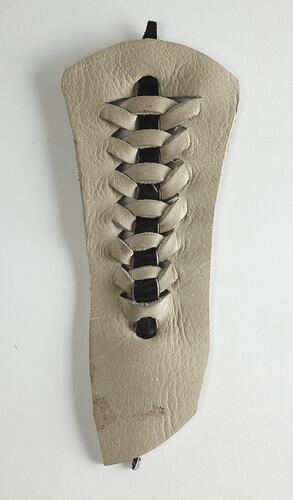Summary
This cream/tan and brown leather interworven leather sample illustrates the finely executed plait stylised weave that Stanio Fancoff used within his various 1950s basketweave shoes. Along with many others, this sample was an integral part of the shoemaker's kit.
Stanio Ivanoff Fancoff was born in 1908 in Bojentsi, a small village in Bulgaria. At age 11, Stanio left home to learn the shoemaking trade. In 1929, he immigrated to Melbourne, settled in Fitzroy and began to work for the V.G. Zemancheff & Sons basket shoe factory in South Melbourne. In1936, he married Dorotea Georgi Touzou who had recently arrived in Australia. Around this time, Stanio set up his own shoemaking business from home, with Georgi, her cousin and sister weaving the shoes which he then assembled. Select shoe samples were then taken to Sydney and Tasmania for sale. In 1942, Georgi and Stanio moved to Broken Hill for Georgi's health; there daughter Nancy was born and Stanio set up a shoe shop/factory. In 1945, Georgi died and by 1950 Stanio and Nancy had moved to Adelaide where he again opened a shoemaking business and shop. He passed away in 1978, having been in the shoemaking business for 59 years. This collection documents his migration and working life experiences.
Physical Description
Small cream/tan leather piece with a dark brown leather strap interwoven within and against its central woven pattern line. The oblong/rectangular cream/tan leather piece has thirteen horizontal slits, whereby each leather strap overlaps its partner and the thin brown leather manoeuvers in an under/over fashion to plat this overlaping format. At the beginning and end of this central weave form are three slices (one at the top and two at the bottom) where the brown leather strap is held to begin and end its journey with a small section of the brown leather extending beyond the central cream/tan leather piece . The leather appears supple but in the lower left area, the leather exhibits signs of staining whilst a diagonal line, a mark or possible scratch runs from the left lower midway point ascending to the right edges midway section. While the leather's front side appears smooth, the reverse side exhibits the skin's natural fibres.
Significance
This collection is significant in documenting a small migrant business as well as the fashion of a particular period. It is well provenanced and charts the application of trade skills in a new country. It also illustrates the stages of hand shoe manufacture from the 1930s, demonstrating the enduring nature of the tools and patterns that were used.
More Information
-
Collecting Areas
-
Acquisition Information
Donation from Nancy Vasileff, 21 Mar 2007
-
Maker
-
Classification
-
Category
-
Discipline
-
Type of item
-
Overall Dimensions
154 mm (Length), 62 mm (Width)
-
References
R.A. Salaman, 'Dictionary of Leather-working Tools c.1700-1950 and Tools of Allied Trades,' London: George Allen and Unwin (Publishers) Ltd, 1986 [Section 2: Boot and Shoe Maker pp18-185]. John Peacock. 'Shoes, The Complete Sourcebook,' London:Thames & Hudson Ltd, 2005. NAA holds file (online) on Vasil George Zemancheff, Fancoff's employer
-
Keywords
Boot & Shoemaking, Bulgarian Communities, Bulgarian Immigration, Immigration, Small Businesses, Tools

